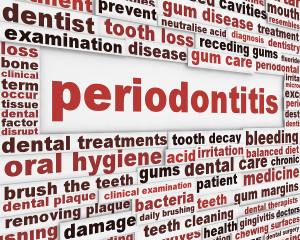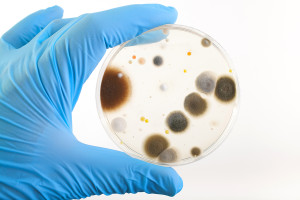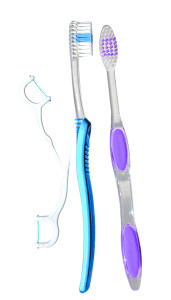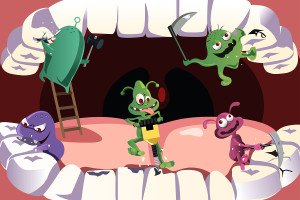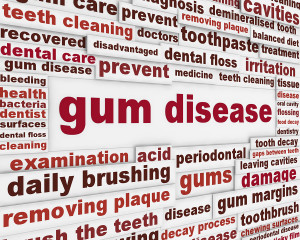Gum disease is experienced by adults in epidemic proportions, yet few people really understand the causes of this condition. Few understand gingivitis and periodontitis treatment options when considering how to effectively protect their teeth and gums. By understanding more about your own oral health and how to monitor it effectively, you can avoid having to undergo expensive and potentially painful dental procedures.
Gingivitis is the first phase of gum disease and it usually presents itself with mild symptoms. It can be reasonably easily reversed with good oral hygiene practice and a thorough, professional cleaning by your dentist. If gingivitis is not treated and gum health restored, then the damage will likely increase.
Gingivitis Symptoms
There are a number of signs that you may have developed gingivitis. If you notice any of these symptoms, then you should visit your dentist immediately in order to reverse the condition, before you begin to experience more advanced symptoms of periodontal disease. Look out for:
- Swollen gums.
- Gums that bleed after brushing or eating.
- Darker or redder than normal gums.
- Persistent bad breath that is present even after brushing your teeth.
By visiting a dentist every six months for a check-up and complete cleaning, you can protect your oral health and also avoid developing gum disease. Your dentist is able to spot the early signs of the condition before you notice them. They can also teach you the right techniques to brush and floss your teeth.
How to Reverse Gingivitis
Generally, it is pretty easy to overcome gingivitis and renew your dental health. All you normally need to do is to follow a regular dental hygiene program at home, which is directed by your dentist. This should include:
- Brushing at least 2 times daily, ideally after meals.
- Floss your teeth to remove food particles that get stuck between teeth.
- Use a natural mouthwash to rinse away residual bacteria (commercial mouthwash can potentially cause more harm than good – beware of toxic ingredients).
By completing these three simple steps you can eradicate much of the bacteria and plaque that grow in your mouth on a daily basis and which are the chief cause of gum disease. Regular brushing, flossing, and rinsing are required as the bacteria are consistently multiplying in your mouth after you eat or drink.
What Happens if Gingivitis is Ignored?
If you ignore the signs of gingivitis and allow the condition to advance, then your gum tissue will deteriorate. Eventually, the gum tissue will become so infected that you will develop periodontal disease.
What happens is that the bacteria in your mouth cause inflammation and infection, which work their way down into the roots of the teeth. When the infection gets down under the gum line, it causes periodontal pockets where large amounts of bacteria can collect and cause more serious infection.
Gingivitis can be easily and quickly treated and you will not experience long-term oral health problems, but periodontal disease is another story entirely. If you have developed periodontal disease, then you are likely to have to undergo more intensive treatments provided by your dentist, or a specialized periodontal dentist.
Treatments can be surgical or non-surgical. Non-surgical treatments generally involve deep cleaning and trying to reduce the amount of bacteria around the gum tissue. By eradicating bacteria that have collected in periodontal pockets and on the gum surface you can stop the disease from progressing.
If the gum disease is very advanced, then surgical procedures are able to restore some aspects of your dental health. Unfortunately, when the periodontitis is severe, there may be some irreversible problems such as tooth loss.
Treatments for Periodontitis
There are a variety of treatments that may be utilized by your dentist when you are suffering from periodontitis. The procedure that is chosen for you will depend on the severity of the condition and may be performed by a regular dentist or a specialized dentist, known as a periodontist.
To overcome this condition requires a series of procedures, medications, and other dental care. It is a lengthy process to restore the damage effects of periodontal disease.
There are four potential phases of treatment for periodontitis:
- Cleaning and scaling of the teeth and gums
- Surgery to restore the gum tissue or remove damaged tissue
- Medication such as antibiotics may be used to prevent further bacterial infection
- Maintenance of gum health and observation
The following explains some of the different periodontitis treatments that are currently being used by dentists:
Non-Surgical Procedures
Non-surgical procedures are usually the first options for treating periodontal disease. They are generally performed when the condition is not too far advanced.
Scaling and Root Planing: Scaling and root planing are commonly performed together to try and remove bacteria and tartar that cause gum disease. Scaling seeks to remove bacteria and tartar by scraping them away using a special dental instrument. Root planing smoothes out the tooth root and removes combats the infection. This treatment is also known as root surface debridement.
Your dentist may use a local anesthetic to limit pain or discomfort during this procedure. The amount of discomfort you are likely to experience depends on how deep the periodontal pockets have become.
Following the procedure you may:
- Have some discomfort or swelling around the site where the procedure was performed.
- Experience increased tooth sensitivity.
- Be recommended over the counter pain relief such as ibuprofen.
- Have to postpone flossing and brush gently in order to avoid aggravating the area.
- Be required to use a chlorhexidine antibacterial mouthwash.
Laser Treatment: Some dentists now use laser therapy to remove damaged or infected gum tissue and tartar. It can also be used to reduce inflammation of the gums.
Antibiotics: Since periodontal disease is caused by a bacterial infection, effective treatment plans will often involve a course of antibiotics. These may be prescribed by the dentist as a tablet or a topical solution to be applied directly to the infected area. Normally, antibiotics will be used along with other non-surgical options.
Surgical Procedures
These days non-surgical treatments for periodontal disease are very effective. In most cases, the condition can be resolved using non-surgical methods. In some circumstances, however, the dentist might decide that surgery is required.
Surgical procedures are generally used when non-surgical efforts have not eradicated the condition, or when the dentist judges that the periodontal disease is too far advanced to benefit from milder treatments.
There are a couple of different treatments for periodontitis that involve surgery. These may be done to restore the gums that have receded or to eradicate diseased gum, and even bone, tissue. The surgeries that can be performed generally fall into one of two categories:
- Pocket reduction procedures – to reduce the pockets that form around the teeth and collect bacteria and infection.
- Regenerative procedures – to restore healthy gum tissue.
Gingivectomy: This procedure is normally performed by a specialist dentist and seeks to remove diseased gum tissue. As well as this, it also restores the receded gums in order to reduce the periodontal pockets where the bacteria collect.
Flap Correction Procedure: This dental surgery will clean the teeth roots and can also repair the damage done to the bone where infection has spread.
Gum Grafting: With uncontrolled infection, the dentist may need to remove diseased gum tissue. In this case, the diseased tissue might need to be replaced with healthy tissue. To do this, the dentist will remove healthy tissue from another site and use it to replace the infected gums.
Tooth Removal: When you have advanced gum disease, the gums begin to recede. One of the most important jobs that your gums do is to keep your teeth firmly in place. When they recede they are unable to offer enough support and the teeth can become loose and even fall out. If the dentist sees that the gums are unable to support the tooth due to disease, then it may be necessary to remove them and replace them with the prosthesis.
Can Surgery Cure Periodontal Disease?
No. Surgery is not able to “cure” the condition. What the non-surgical and surgical treatments can offer is a cleansing. These procedures can restore the gum health to a certain extent; however, it is up to the patient to ensure that they follow the treatment fully. Only full and consistent treatment can keep bacteria in check.
Gum disease is caused by bacterial overgrowth and infection. In order to “cure” the condition, consistent removal of the bacteria that accumulate in your mouth every day is needed.
Once dental surgery or other treatments have been performed, the patient needs to be very careful about home oral hygiene.
Looking After your Dental Health
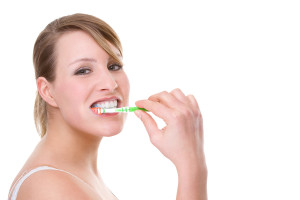
Each time you eat something bacteria grow in your mouth. The bacteria and your saliva mix and produce the sticky, yellowish substance known as plaque. Plaque can harden into what is called tartar. This is what your dentist scrapes away with a metal object while at your cleaning visit. The destructive process of bacteria, plaque and tartar are one of the causes of gum disease.
In order to prevent these substances from causing disease, you need to follow a consistent home dental hygiene routine. This should include:
- Brushing – at least twice a day, but preferably after each meal.
- Flossing.
- Using a mouthwash.
- Visiting your dentist for check-ups.
By following the above four steps, you will be able to keep bacterial growth at bay. This is the only effective way to prevent infections, disease, cavities and other dental problems in the long-term.
Selecting Dental Products
In addition to following a stringent oral health routine, you need to be careful about the dental products that you use. Some products available on the market contain chemicals that can actually damage sensitive gum tissue.
- Sodium Lauryl Sulphate: Try to avoid products that contain sodium lauryl sulfate. This chemical is a foaming agent that is used in many dental preparations, shampoos, beauty products and cleaning liquids. However, it can worsen existing oral health issues and damage your gum tissue. Some studies have even identified this ingredient as a potential carcinogenic.
- Alcohol – A number of mouthwash products contain alcohol, but it is best to avoid it. The reason is that alcohol actually dries out your mouth, which makes it more favorable for bacteria to flourish. Since gum disease is caused by an overgrowth of bacteria, you want to avoid encouraging its presence.
When you are shopping for dental products, check the labels to ensure that they do not contain either of the above chemicals. Products that contain natural ingredients, such as tea tree or peppermint oil, are a great alternative to standard toothpaste and mouthwash that have harsh ingredients.
Further Tips for Protecting Oral Health
In order to combat periodontal disease, there are a couple of extra things that you can do. Take a look at your lifestyle and make some simple changes that can improve not only your oral health but your overall well-being.
- Quit smoking – there are few things worse for your teeth and gums than smoking. It encourages bacterial growth and infection; leaches vitamins from your organism that are required for healthy teeth and gums and reduces circulation to the gum tissue.
- Sugar – Bacteria just love to feed on sugar, so cut out as much sugar from your diet as possible.
- Eat fresh – reduce the amount of processed foods that you eat and replace them with fresh produce. This will provide you with much-needed vitamins and minerals to support good dental health.
- Reduce stress – stress is one of the biggest causes of illness and disease. By finding better ways to handle stress, you will enjoy a much better level of health.
- Visit your dentist regularly – check-ups every six months are necessary In order to maintain good oral health and prevent any problems from developing into acute conditions. Ask your dentist how to reverse receding gums naturally with botanical oils such as spearmint and peppermint — effective bacteria killers.
Periodontal disease treatment can be very effective and help you to avoid long-term dental problems. However, prevention is always better so ensure that you follow the above advice in order to maintain a healthy mouth.
